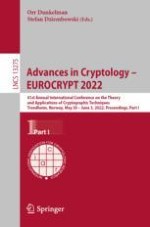2022 | OriginalPaper | Chapter
COA-Secure Obfuscation and Applications
Authors : Ran Canetti, Suvradip Chakraborty, Dakshita Khurana, Nishant Kumar, Oxana Poburinnaya, Manoj Prabhakaran
Published in: Advances in Cryptology – EUROCRYPT 2022
Publisher: Springer International Publishing
Activate our intelligent search to find suitable subject content or patents.
Select sections of text to find matching patents with Artificial Intelligence. powered by
Select sections of text to find additional relevant content using AI-assisted search. powered by
Abstract
-
A new form of software watermarking, which provides significantly broader protection than current schemes against counterfeits that pass a keyless, public verification process.
-
Completely CCA encryption, which is a strengthening of completely non-malleable encryption.
